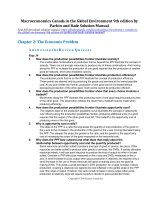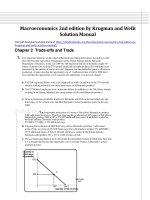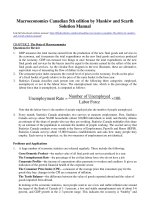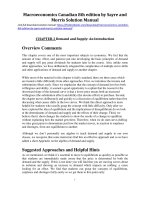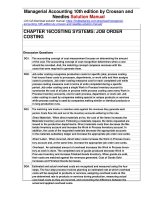Macroeconomics canadian 8th edition by sayre and morris solution manual
Bạn đang xem bản rút gọn của tài liệu. Xem và tải ngay bản đầy đủ của tài liệu tại đây (2.71 MB, 67 trang )
Macroeconomics Canadian 8th edition by Sayre and
Morris Solution Manual
Link full download solution manual: />
CHAPTER 2 Demand and Supply: An Introduction
Overview Comments
This chapter covers one of the most important subjects in economics. We feel that the
amount of time, effort, and patience put into developing the basic principles of demand
and supply will pay great dividends for students later in the course. Also, unlike some
other approaches, we have deliberately relegated the complexities of multiple curve shifts
and other applications of demand and supply to another chapter.
While most of the material in this chapter is fairly standard, there are three areas which
are treated a little differently from other approaches. First, we introduce the income and
substitution effects early. Since we emphasize that the concept of demand involves both
willingness and ability, it seemed a good opportunity to explain that the reason for the
downward slope of the demand curve is that a lower price means both an increased
willingness (the substitution effect) and ability (the income effect) to purchase. Second,
the chapter moves deliberately and quickly to a discussion of equilibrium rather than first
discussing what causes shifts in the two curves. We think this direct approach is more
helpful for students who usually grasp the concept with little difficulty. Only after we
have explored the idea of equilibrium and the implications of disequilibrium do we look
at the determinants of demand and supply and the effects of their change. Third, we
believe that it short-changes the students to show the results of a change in equilibria
without explaining how the market gets there. Therefore, when we do start curve-shifting
we take great pains to demonstrate just how the market moves, in reaction to surpluses
and shortages, from one equilibrium to another.
Although we don’t personally use algebra to teach demand and supply in our own
classes, we recognize that some instructors find this an effective approach and so we have
added a short Appendix on the algebra of demand and supply.
Suggested Approaches and Helpful Hints
As we mentioned, we think it’s essential to move to equilibrium as quickly as possible so
that students are immediately made aware that the price is determined by both the
demand and the supply. If this is not done you will find that you are moving curves about
in isolation and showing an increase in demand which impacts on nothing: a cause
looking for an effect. We find that students can grasp the concepts of equilibrium,
surpluses and shortages fairly easily so we get them to this point early.
1
Principles of Macroeconomics, 8th Edition - Instructor's Manual - Chapter 2
Students need to be aware that the price of the product is not always the most important
factor that affects consumer spending. At times, incomes, prices of related products and
so on may have more significance. Yet we put price at the forefront for two reasons.
First, it often is the most important factor. Second, it is the centre of focus for our
analysis because it is the one factor which links producers and consumers and which
influences the actions of both groups.
It is probably useful to point out to students that some of the demand curves in this
chapter are not straight lines. This is because they are plotted from data that is presented
in a table. This helps to emphasize the link between a demand schedule and a demand
curve and reminds us that demand and supply curves are not always linear.
One of the problems that many students have is the obvious one of confusing demand
with quantity demanded (and supply with quantity supplied). The problem is only cured
through repeated practice. It’s a good idea to keep reminding students that the terms
demand and supply do not relate to specific quantities but to whole ranges of prices and
quantities. We find that while they often respond to the concept of demand, they will
sometimes continue to use the term supply as a synonym for production or output.
Another problem for students is that, understandably, they draw on examples where the
firm rather than the market determines the price of the product. Although we briefly
mention in the text that the demand/supply model works best in the context of perfectly
competitive markets, it is a shame to use only examples of commodity markets. Once
students grasp the basics, they are usually eager to put the principles to work analyzing
many different types of markets with which they are familiar, and these include markets
which are anything but competitive and where the producers are usually price makers.
We are hesitant to curb such enthusiasm so early in the game. On the other hand, you
need to tread carefully when dealing with non-competitive markets. Perhaps you could
explain, as we do early in Chapter 3 with the example of the over-priced automobile, that
while the model works exactly as we suggest only in perfectly competitive markets, that
doesn’t mean that it doesn’t have application to other markets.
Answers to Problems for Further Study
1. c, d and e are the circled letters
2. Graph A: increase in demand; increase in quantity supplied
Graph B: increase in supply; increase in quantity demanded
3. a) price down and quantity traded down
b) price up and quantity traded up
c) price down and quantity traded down
2
Principles of Macroeconomics, 8th Edition - Instructor's Manual - Chapter 2
d) price up and quantity traded up
4. a) supply;
b) demand;
c) supply;
d) demand;
increased
decreased
decreased
increased
5. Demand refers to the whole range of quantities that are demanded at various prices as
depicted by a demand schedule or demand curve. The quantity demanded refers to a
particular quantity at a particular price, i.e. it is a point on a demand curve.
6. Shortages cause competitive bidding among buyers of a product. The result will be
that the price will be bid up and will continue to rise until the shortage disappears.
7.
Table 2.19 (completed)
D
a
b
c
d
e
f
S
-
P
Q
-
8. Change the second sentence to: “The quantity demanded for houses decreases when
the price increases.”
9. The first determinant of market demand is consumer preferences, i.e. the tastes and
fashions of consumer. The second is consumer incomes. For a normal product, higher
incomes leads to a higher demand; on the other hand, for an inferior product higher
incomes lead to a lower demand. The third determinant is the prices of related
products, which include substitute products, and complementary products. The
demand will be higher if the price of a substitute increases or the price of a
complement decreases. The fourth determinant is expectations of the future. The
demand will increase if future prices or incomes are expected to be higher or a future
shortage is anticipated. The final determinant is the population. The market demand
for a product may be affected if there is a change in the size or in the income or age
distribution of the population.
10. An increase in the demand for a product will initially lead to a shortage. As a result
competition among the buyers will cause the price to increase. The effect of an
increase in the price will be a fall in the quantity demanded and an increase in the
quantity supplied. Both factors will help to eliminate the shortage. Eventually both
the price and the quantity traded of the product will have increased.
3
Principles of Macroeconomics, 8th Edition - Instructor's Manual - Chapter 2
11. Five possible causes are:
an increases in the price of resources used;
an increase in business taxes;
an increase in the price of a substitute in production;
the expectation of suppliers that there will be higher prices in the future;
a decrease in the number of suppliers.
Five specific effects (in order) are:
a shortage;
a price increases;
an increase in the quantity supplied;
a decreases in quantity demanded;
a decrease in the quantity traded.
12.
S1
S2 (S1 + 5000)
Rental
P1
P2
D
Q1 Q2
Number of Rental Units
APPENDIX TO CHAPTER TWO
Answers to Problems for Further Study
1. P = 6;
Q = 28.
2. a) P = 15;
Q = 25.
b) Shortage of 12.
4
Principles of Macroeconomics, 8th Edition - Instructor's Manual - Chapter 2
c) P = 17;
Q = 27.
d
3. a) Q = 244 – 4P
b) Qs = –8 + ½ P
c) P = 56;
Q = 20
d
d
4. a) Q = 675 – 100P (or P = 6.75 – 0.01Q ).
s
s
b) Q = 50P (or P = 0.02Q )
c) P = 4.5;
Q = 225
d
s
d
s
5. a) shortage of 60. (Q = 185; Q = 125)
b) surplus of 24. (Q = 164; Q = 188
6. a) P = 70. (Solve the equation: 380 = 100 + 4P)
d
b) Q = 310. (Plug 70 into the demand equation.)
d
s
c) Surplus of 70. (Q = 310 and Q = 380).
5
SAYRE // MORRIS
Eighth Edition
CHAPTER 2
Demand and Supply:
an Introduction
Stephen Mullins, St. Clair College
© 2014 McGraw-Hill Ryerson Limited
2-1
CHAPTER 2
Demand and Supply:
an Introduction
Learning Objectives:
1.
2.
3.
4.
Explain the concept of demand
Explain the concept of supply
Explain the term market
Explain the concept of equilibrium
© 2014 McGraw-Hill Ryerson Limited
2-2
CHAPTER 2
Demand and Supply:
an Introduction
Learning Objectives:
5. Demonstrate the causes and effects of a change
in demand
6. Demonstrate the causes and effects of a change
in supply
7. Explain why demand and supply determine
price and quantity traded
© 2014 McGraw-Hill Ryerson Limited
2-3
LO1
Demand
Demand
– The quantities that consumers are willing and
able to buy over a period of time at various
prices
© 2014 McGraw-Hill Ryerson Limited
2-4
LO1
Demand
Demand
– The quantities that consumers are willing
and able to buy over a period of time at
various prices
• Must be willing to purchase it
AND
• Must have ability to pay for it
© 2014 McGraw-Hill Ryerson Limited
2-5
LO1
Demand
Demand
– The quantities that consumers are willing
and able to buy over a period of time at
various prices
• Measures quantities in a specific time period,
e.g. a week / month / year
© 2014 McGraw-Hill Ryerson Limited
2-6
LO1
Demand
Demand
– The quantities that consumers are willing
and able to buy over a period of time at
various prices
• Shows relationship between quantity & price
• Price is the most important determinant
– “Ceteris paribus” – all else remains the same
© 2014 McGraw-Hill Ryerson Limited
2-7
LO1
Demand
Demand Schedule
– A table showing the various quantities
demanded at different prices
Demand Curve
– A graphic representation of a
demand schedule
© 2014 McGraw-Hill Ryerson Limited
2-8
LO1
Demand Schedule
Price Per Case
Quantity Demanded
(cases per month)
$17
18
19
20
21
22
7
6
5
4
3
2
© 2014 McGraw-Hill Ryerson Limited
2-9
LO1
Demand Curve
Price
Quantity
Price
$17
7
$19
$18
$17
18
19
20
6
5
4
21
22
3
2
1
2
3
4
5
6
7
Quantity
© 2014 McGraw-Hill Ryerson Limited
2-10
LO1
Demand Curve
Price
$19
$18
$17
Demand curve
1
2
3
4
5
6
7
Quantity
© 2014 McGraw-Hill Ryerson Limited
2-11
LO1
Demand Curve
Price
Price
$17
Quantity
7
18
19
20
6
5
4
21
22
3
2
$19
B
$18
A
$17
1
2
3
4
5
6
7
Quantity
© 2014 McGraw-Hill Ryerson Limited
2-12
LO1
Demand Curve
Price
$19
$18
As price increases,
quantity demanded
decreases.
Movement is along
the existing demand
line.
B
A
$17
1
2
3
4
5
6
7
Quantity
© 2014 McGraw-Hill Ryerson Limited
2-13
LO1
Why the Demand Curve
Slopes Downward
1. Income effect
– The effect of a price change on real income,
and therefore on quantity demanded
– Real income is measured in terms of the
goods and services it will buy
– Real income will increase if prices fall
© 2014 McGraw-Hill Ryerson Limited
2- 14
LO1
Why the Demand Curve
Slopes Downward
2. Substitution effect
– The substitution of one product for another
as a result of a change in their relative prices
© 2014 McGraw-Hill Ryerson Limited
2- 15
LO1
Market Demand
Market Demand
– The total demand for a product or
service from all consumers
© 2014 McGraw-Hill Ryerson Limited
2-16
LO1
Market Demand Schedule
Quantity demanded (cases/month)
$/case
Tomiko
Abdi
Jan
$18
$19
6
5
+ 4
4
+ 9
7
$20
4
4
6
14
$21
3
3
3
9
$22
2
3
1
6
© 2014 McGraw-Hill Ryerson Limited
Market
demand
=
19
16
2-17
LO1
Market Demand Schedule
P
Market demand is the horizontal
summation of all individual
22
21
demands.
20
19
D
D
18
JAN
TOMIKO
D
D
MARKET
ABDI
0 2 4 6 8 10 12 14 16 18 20
Q
© 2014 McGraw-Hill Ryerson Limited
2-18
LO1
Test Your Understanding
The table shows the weekly demand for soy milk by
three people in a very small market.
a. Calculate market demand at each price.
Quantity demanded by:
Price
Al
$4.00
1
3.50
Bo
Cole
Market
+ 0
+ 0
= 1
1
1
0
2
3.00
1
1
1
3
2.50
2
1
1
4
2.00
2
2
1
5
© 2014 McGraw-Hill Ryerson Limited
2-19

